2.
GHANA
Timber exports improved in January
According to the Timber Industry Development Division
(TIDD) of the Forestry Commission, wood and timber
product exports from Ghana in January 2011 totalled
23,948 cu.m valued at Euro 7.9 million, compared to
26,430 cu.m and Euro 8.27 million in January 2010. This
represents a decline of 9.4% and 4.4% in volume and
value respectively.
In January 2011, exports of all timber products declined
except for plywood, moulding and parquet/flooring.
Exports of primary products, including poles and billets,
were valued at Euro 3 million in January compared to
Euro 3.6 million in January 2010. Similarly, the value of
exports of secondary timber products declined 3.5%, from
Euro 7 million in January 2010 to Euro 6.8 million
January 2011. However, exports of tertiary products were
valued at US$902,209 in Janaury 2010, up steeply by 32%
from US$681,275 in January 2010. Primary products,
secondary products and tertiary products accounted for
3%, 86% and 11% of the total export value respectively.
In January 2011, the share of Ghana¡¯s exports of wood and
timber products to other countries in Africa was 51% of
the total export value, compared to 36% in January 2010.
Exports to other destinations included Europe (26% of the
total export value), Asia/Far East (15%) and the Middle
East (5%). The main importing countries in Europe were
Italy, France, Germany, the UK, Belgium, Spain, Ireland
and the Netherlands.
Plywood accounted for 38% of the total exports of wood
and timber products exports from Ghana in January 2011.
Compared to January 2010, plywood exports rose 9.2% in
volume and 32% in value. The main importing countries
for Ghana plywood were Nigeria, Niger and Togo. Ceiba,
Mahogany and Ofram were the principal species utilised
for plywood production.
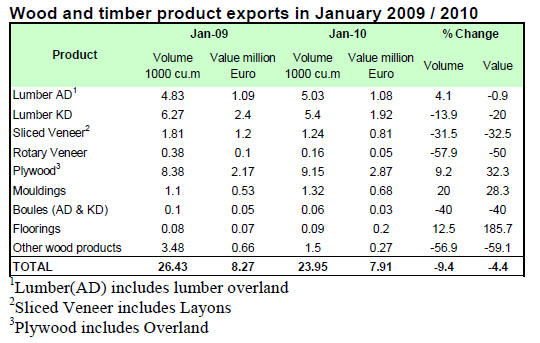
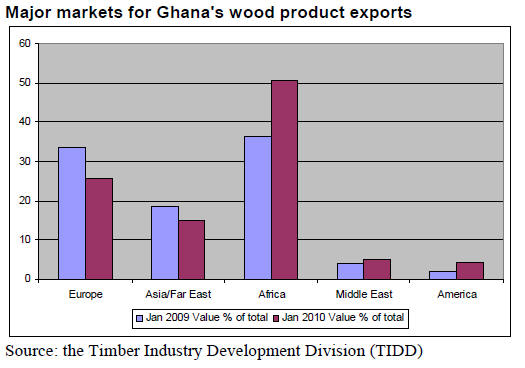
Reduced tariffs for electricity and water announced
Ghana's Public Utility Regulatory Commission (PURC)
announced reductions in utility tariffs for electricity and
water. The reductions range from 0 to 6.58% for
residential electricity consumers and from 0 to 13.38% for
non-residential consumers. Non-residential consumers will
also enjoy a 6.86% tariff reduction for water. These
revisions on tariffs were made on the back of lower
production costs resulting from the completion of the West
Africa Gas Pipeline.
Analysts were pessimistic over the impact of the revised
tariffs on total operating costs which are dependent on
several other factors.
Lending rate maintained to rein in inflation
The Monetary Policy Committee decided to keep its Prime
Rate at 13.5%, unchanged since July 2010 due to potential
risks in the fiscal outlook and inflation which climbed in
January 2011 for the first time in 19 months.
In addition, authorities will continue to intervene in order to
prevent the Cedi from a further freefall.

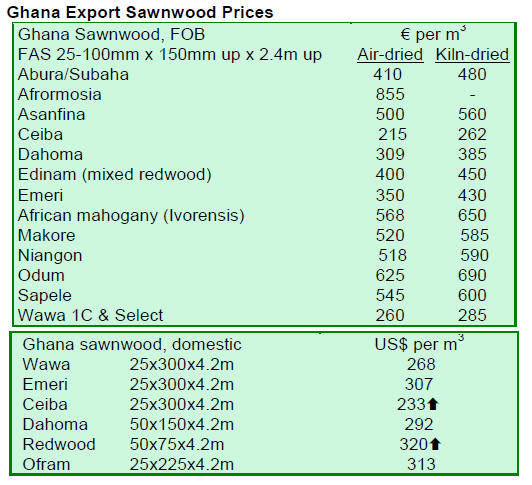
3.
MALAYSIA
Bulk of Malaysian furniture destined for exports
In terms of consumer spending on furniture, Europeans
and Americans spent an average of US$540 and US$300
per year respectively. However, Malaysians spent only an
average of US$40 per year. Although Malaysian furniture
is of international standards, most Malaysians prefer
imported furniture over domestic products.
Consequently, some 85% of furniture manufactured in
Malaysia are for exports. According to trade statistics, the
US remained the largest market accounting for RM1.98
billion of Malaysian furniture exports from January to
October 2010, followed by Japan (RM573 million),
Singapore (RM477 million) and the UK (RM407 million).
Other important export destinations include Australia,
Canada, Germany, India, the UAE and Saudi Arabia.
Asian is emerging as an important market for Malaysian
furniture exports on account of population reaching 1.3
billion in China, 1 billion in India and 550 million in the
ASEAN economic zone.
Tight supplies of rubberwood and palm fibres
Prices of Malaysian timber products continue to climb
across the board in line with other commodity prices.
Rubberwood prices remain buoyant as natural rubber
futures prices breached US$6.44 per kg in the Tokyo
commodity exchange TOCOM.
Similarly, with crude palm oil futures prices within the
range of RM3,600 per tonne, the supply of palm fibres, an
important component of most panel products, has become
tighter.
According to an analyst, supplies of rubberwood and palm
fibres will remain tight if high price levels of natural
rubber and palm oil are maintained in the international
markets.

4.
INDONESIA
Agreement on key points of moratorium reached
The Indonesian president is expected to sign a presidential
decree, laying the legal framework for the 2-year
moratorium on new permits to convert natural forests and
peatlands.
The Indonesian Presidential Delivery Unit working on
two
alternative drafts, has reached an agreement on the key
points of the moratorium. Secondary forests already
converted are excluded from the moratorium, but the
decree will incorporate mechanisms to protect pristine
forests and rehabilitate degraded forests.
Indonesia to sign VPA within 3 months
The Jakarta Post reports that Indonesia is hoping to sign
the Voluntary Partnership Agreement (VPA) under
FLEGT Action Plan with the EU within the next 3 months.
If this materialises, Indonesia would become the first
country in Asia to conclude such an agreement which
would require that only legally verified timber and timber
products from Indonesia be can supplied to the EU market.
The Jakarta Post quotes Iman Santoso, Director General
for Forest Business Management at the Ministry of
Forestry, Indonesia:
¡°We're nearly there. This agreement is crucial for
Indonesia as it enables Indonesian timber exporters to
expand their market for timber and timber products in the
EU¡.This is especially important because the EU has just
enacted a timber regulation prohibiting the sale of illegally
harvested timber in the EU market by March 2013¡±. The
value of Indonesia's timber trade with the EU stands at an
estimated US$1 billion per year.
Indonesia and Finland ink deal on renewable energy
sources
Indonesia and Finland signed a bilateral agreement to
promote wood-based biomass and agricultural residue as
renewable energy sources in the provinces of Central
Kalimantan and Riau.
The bilateral agreement will form the basis for the
Energy
and Environment Partnership (EEP) programme, designed
to reduce greenhouse gas emissions and combat climate
change.
The Finnish Ministry for Foreign Affairs had earmarked
Euro 4 millions for Indonesia to implement the
programme from 2011 to 2014. The programme will
enable Indonesia to access modern technologies in
renewable energy production.
Plywood in demand
Indonesian plywood manufacturers are hoping to benefit
from the current high prices of plywood. This will enable
them to upgrade machines and purchase spare parts.
Plywood manufacturers are also beginning to hire more
workers to cope with export demand.
Furniture manufacturers are also more optimistic as
more
orders are coming in from the Middle-East despite the ongoing
political unrest.

5.
MYANMAR
Market outlook remains favourable
The favourable market situation for teak and other
hardwoods remains unchanged from the previous month,
with marginal gains in prices. Market prospect for kanyin
logs has also improved particularly for veneer production.
At Myanmar Timber Enterprise (MTE) tender sales, the
higher grade teak SG5 logs fetched lower prices than the
lower grade teak SG6 logs. According to an analyst, this
was due mainly to forest area preference and grading.
All teak SG6 logs came from special and first class
areas,
while 42% of SG5 logs originated from second and third
class areas. An analyst says that besides the origin, prices
are determined by other factors including buyers¡¯
preference.
Other hardwood tender sales in February were done at
favourable prices indicating improving markets. Some 265
tonnes of export quality pyinkadoe logs fetched US$561 -
US$762 per Hoppus tonnes (MTE list price US$678). In
addition, some 500 tonnes of export quality kanyin logs
fetched US$424 - US$434 per Hoppus tonnes (MTE list
price US$390).
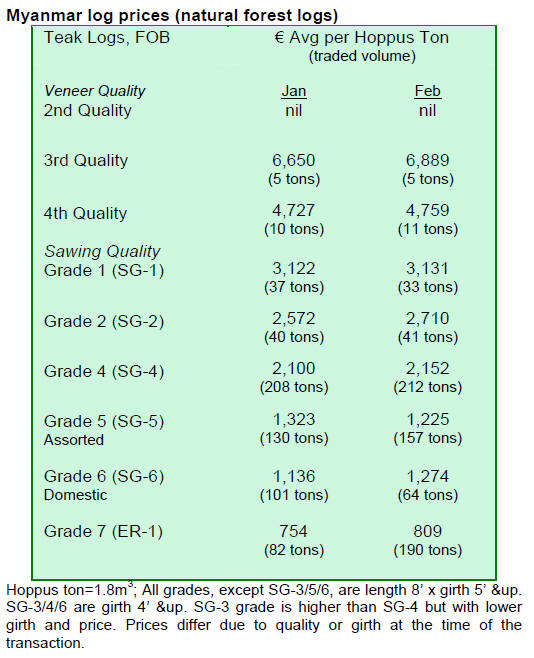
6. INDIA
India maintains robust growth in
trade
According to the Ministry of Commerce and Industry,
exports in January 2011 reached US$20.6 billion, 33%
higher than in January 2010.
Imports also rose to US$28.6 billion in January
2011, up
13% from the same month in 2010.
Declining exports to North America and Europe are
being
offset by increasing exports to Latin America, Africa and
Asia.
Plywood in good demand
According to an analyst, domestic demand for processed
timber products is on the rise.
Demand for plywood is good with imports from China
increasing. However, the quality of the plywood imported
has gone down.
Teak prices trending upwards
Timber auction sales in government depots were brisk in
January with arrivals of fresh teak logs. As prices for
imported teak climb, auction sale prices are also up.
In addition to fresh logs, remaining logs from
earlier
auctions as well as logs harvested during previous season
were sold in February auction sales.
There have been less arrivals of teak in depots of
Maharashtra. Gujarat auctions sales ground to a halt as
bidders objected to the electric auction sales system
introduced by the local government to be launched in
March 2011. In contrast, sales in Madhya Pradesh were
more active. Teak supply remained good in Central Indian
depots with arrivals from Hoshangabad, Jabalpur, Harda
and Baitul.
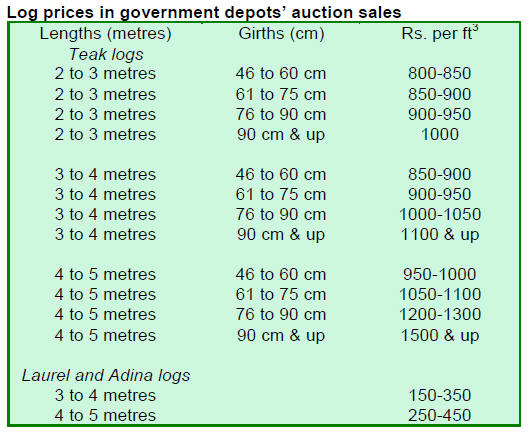
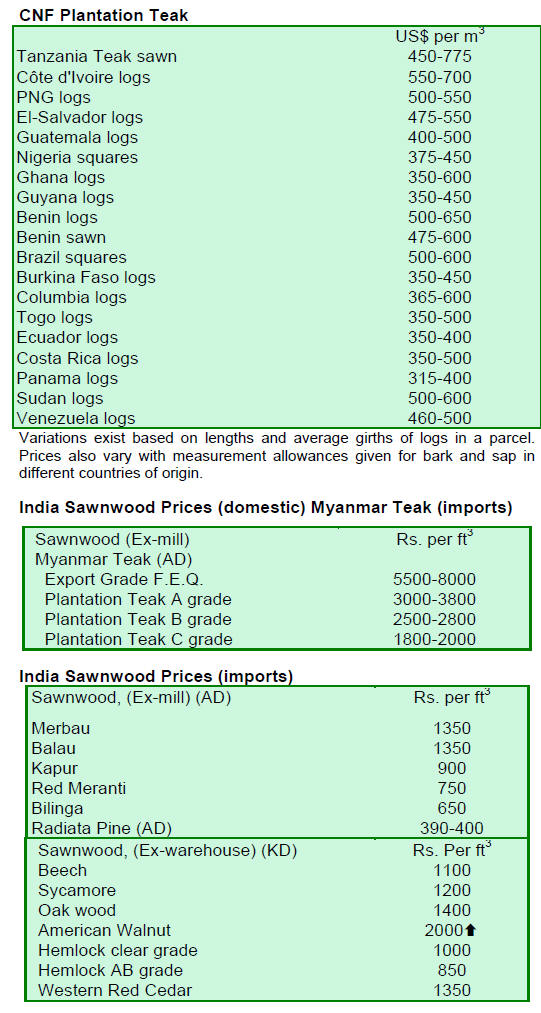
7. BRAZIL
Prices of timber products on an
upward trend
The average price of timber products in Brazil in BRL
increased by 1.24% from the previous fortnight. Prices in
US dollars also gained 2.73% due to the slight
appreciation of the Brazilian currency against the US
dollar.
Exports of tropical timber products continue to
decline
In January 2011, exports of timber products (excluding
pulp and paper) jumped 13.7% to US$170 million
compared to US$149 million in January 2010.
However, exports of tropical sawnwood declined in
terms
of both volume and value, from 39,000 cu.m worth US$20
million in January 2010 to 36,100 cu.m valued at US$17.8
million in January 2011, representing 7.4% decline in
volume and 11% in value.
Exports of tropical plywood also dipped, plummeting
19%
from 6,300 cu.m in January 2010 to 5,100 cu.m in January
2011. In value terms, the drop was 17%, from US$3.5
million to US$2.9 million.
For wooden furniture too, the value of exports
declined
10% compared to the level in January 2010 to US$30.8
million in January 2011.
In contrast, pine sawnwood exports jumped 38% in
January 2011 compared to January 2010, from US$8.1
million to US$11.3 million. In terms of volume, exports
rose 27% from 39,100 cu.m to 49,600 cu.m over the
period.
The value of pine plywood exports also surged 26%
in
January 2011 compared to the level in January 2010, from
US$21.6 million to US$27.3 million. In terms of volume,
exports rose 15% from 66,200 cu.m to 76,100 cu.m over
the period.
First hike in prime interest rate since July 2010
According to the Brazilian Institute of Geography and
Statistics (IBGE), the Consumer Price Index (IPCA) in
January 2011 increased 0.83% over the level recorded in
January last year, up 0.20 percentage points compared to
December 2010.
In January 2011, the average exchange rate to the
US
dollar was BRL1.67/US$ compared to BRL 1.78/US$
during the same month of 2010, showing further
strengthening of the Brazilian Real against the US dollar
over the period.
For the first time since July 2010, the Copom
(Economic
Policy Committee) raised the prime interest rate (Selic) by
0.5 percentage points to 11.25% per year in January 2011.
Economic assessment of forest concessions in
Par¨¢
The Brazilian Forest Service (SFB) and the Timber
Exporters Association of the State of Par¨¢ (AIMEX) will
organise a meeting on economic aspects of forest
concessions. The meeting is to assess prospects and
opportunities for trade and financing of forestry activities
in Par¨¢. The strategy for the forestry sector in Par¨¢ is to
increase its share in the domestic and foreign markets by
expanding forest concession areas under sustainable
management and attracting more financing.
SFB opened a bidding process for forest concessions
of
210,000 hectares in the Aman¨¢ National Forest. SFB plans
to launch three other bidding processes for forest
concessions covering 700,000 hectares in the context of
the management of national forests in the state of Par¨¢. In
addition, a forest concession of 48,800 hectares in the
Sarac¨¢-Taquera National Forest is expected to become
operational this year.
The national forests of Altamira, Aman¨¢ and Crepori
in
the regions of Itaituba and Jacareacanga of the state of
Par¨¢ cover altogether an area of over two million hectares.
It is estimated that 300,000 hectares of forests are required
under concession management per year in order to meet
the current demand for tropical timber in the state of Par¨¢.
Concessions are usually granted for period of 40 years to
facilitate effective combating of illegal forest activities and
promoting legal timber operations, commercialisation and
processing.
The volume of timber production in Par¨¢ was 6.6
million
cu.m in 2009, accounting for 47% of the total domestic
timber production. Par¨¢ was also the largest producer of
processed timber in Brazil at 2.5 million cu.m and
generated the highest gross revenue from logging with
BRL 2.17 billion in 2009, according to SFB.
Par¨¢ timber product exports on the mend
The value of manufactured and industrial timber product
exports from Par¨¢ in 2010 rose 11.7% to US$387 million
compared to 2009. In terms of volume, exports rose only
0.33% to 360,952 tonnes, still far below the record level of
exports of 1,016,678 tonnes worth US$793 million in
2007.
The total exports of Par¨¢ in 2010 were valued at
US$ 12.8
billion, up sharply by 54% over 2009. The timber sector
was the third largest exporter in the state.
The US continues to be the main export destination
for
timber products from Par¨¢ accounting for US$120 million
of the value of exports in 2010, up 9.7% compared to
2009.
In Brazil, the state of Parana is the largest wood
and
timber product exporter with a value of exports of US$647
million in 2010, followed by Santa Catarina (US$410
million) and Par¨¢.
Timber industry calls for cost sharing
The timber industry has called for sharing of maintenance
and infrastructure costs of public forests by the public and
private sectors.
According to the Timber Exporters Association of
the
State of Par¨¢ (AIMEX), forest concessions generate social
and environmental benefits for the states in the Amazon
and, as such the cost of a Forest Management Unit (FMU)
should be lower. Currently, the minimum price of a FMU
may be as high as BRL 2 million.
Restricting logging during the rainy season
The federal rule restricting logging, skidding and
transportation of timber in Mato Grosso was implemented
for the first time in 2010. For this year, the federal rule is
effective during the rainy season from 1 February to 1
April. However, forest engineers responsible for forest
management areas can extend the period in accordance
with the prevailing conditions in each area.
Log trade and transportation is only allowed from
timber
yards with forest roads built according to forest
management plans.
The aim of the rule is to address the problems of
soil
degradation and damage caused by logging undertaken
during the rainy season.

8. PERU
Congress debate on draft law deferred
As reported earlier, the Congressional debate on the draft
Forestry and Wildlife law was deferred to the next term
from March to June 2011. The consultations with
indigenous people were extended by 60 days to the end of
February. During that extended consultation period, the
minimum requirements and an agreement on the next draft
are expected to be completed.
The new Forestry and Wildlife law is needed to
fulfil the
conditions of the Free Trade Agreement (FTA) with the
United States.
Growth in exports to China
The China¨CPeru Free Trade Agreement (FTA) came into
effect on 1 March 2010. Following the FTA, Peruvian
exports to China have registered robust growth. The total
value of Peruvian exports to China in 2010 soared 33% to
US$5.4 billion from US$4.1 billion in 2009. Wooden
flooring were among the non-traditional timber products
which were able to make significant gains in sales to
China.
China is the main destination for Peru timber
exports,
accounting for 43% of the total value of Peruvian timber
exports.
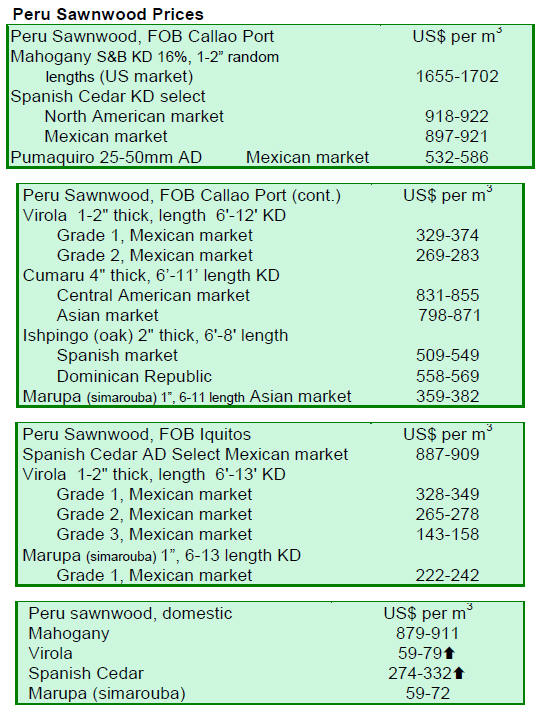
9.
GUYANA
Timber prices trending upwards
During the period under review, there were again no
exports of greenheart logs which was one of the main
species used in domestic value-added production. Export
sales of purpleheart logs were brisk at favourable prices
especially for standard and fair sawmill qualities, while
mora prices retreated marginally during this fortnight
period.
For sawnwood, prices for undressed greenheart
(select
quality) increased from US$806 per cu.m in last fortnight
to US$975 per cu.m in the period under review. Undressed
greenheart (sound quality) attracted a high average price
of US$784 per cu.m, while prices for undressed greenheart
(merchantable) reached US$806 per cu.m. For undressed
purpleheart (select quality) prices shot up to US$1,450 per
cu.m, from US$650 recorded a fortnight ago, while upper
bound prices for undressed purpleheart (sound quality)
advanced to US$825 per cu.m from US$615 per cu.m.
However, the volume of exports was small.
Similarly, dressed greenheart attracted favourable
prices
for both prime and standard qualities. Guyana¡¯s Washiba
(Ipe) continued to be in demand in the North American
markets, fetching a high average price of US$US2,050 per
cu.m for this fortnight period. Splitwood prices also
climbed to US$1,182 per cu.m with the main export
destination being the Caribbean.
For the period under review, exports of value-added
products including wooden doors, indoor furniture,
mouldings, wooden utensils and ornaments also
contributed to total export earnings.
Booming housing sector drives domestic demand up
The government of Guyana is encouraging forest
concessionaires to optimise timber production under the
state¡¯s sustainable management plan in order to meet
increasing domestic demand for sawnwood driven by the
booming housing sector in the country.
Due to a projected increase in public spending on
housing
in 2011, domestic consumption of sawnwood is expected
to grow sharply by 40% from the level in 2010, to 300,000
cu.m in 2011.
In 2010, total production of logs production was
420,000
cu.m of which around half was exported. In order to meet
projected domestic and export demand for 2011, a
benchmark of 60% of the annual allowable cut has been
set for log harvest in forest concessions. At this level, the
rate of deforestation in Guyana can be kept at the current
low level.
The Guyana Forestry Commission is currently
granting
new concessions for the management of state forests to
designated communities in an attempt to improve the
livelihoods of forest communities and increase timber
production. In addition, with the establishment of three
kiln drying facilities across the country, Guyana¡¯s focus
remains on reducing log exports and increasing domestic
production of value-added products.

10.
BOLIVIA
Business Round Table in Bolivia
The 7th Business Round Table of the Timber Industry will
be held on 24-25 March 2011 in Santa Cruz, Bolivia.
Participants will include local and international timber
industry companies, as well as machinery and equipment
providers and consultants.
http://www.cfb.org.bo/CFBInicio/

Related News: